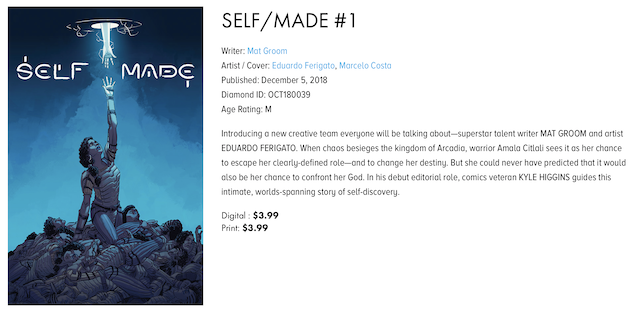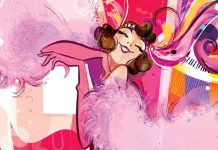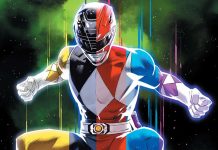In my interview with Kyle Higgins, he mentioned that he is editing a new Image comic called Self/Made, describing it as exploring “relationship between a creation and their creator.” I was captivated by the concept but not sure what to expect from new comic book creator Matt Groom. Any doubts I had were assuaged within four pages and SELF/MADE #1 became my favorite first issue of 2018. For that reason, I was excited to chat with Groom and learn more about his thoughts on writing comics, his collaboration with the creative team, and crossing genres in fiction.
All art by Eduardo Ferigato and Marcelo Costa
I believe this is the first comic you’ve written. How did you teach yourself to write for the medium?
Technically it’s not quite my first comic– I co-wrote an 8-page story for a BOOM! Studios Power Rangers annual. But, yeah, functionally speaking, this is my debut.
I guess I’d say I learned in a bunch of different ways over a long period of time. I’ve been reading up on story structure and dynamics for my day job at a creative agency for a number of years now. I’ve been listening to and reading interviews with writers wherever I can find them. I’ve been reading comics for almost as long as I’ve been able to read at all. All of this forms a base level of knowledge.
In terms of the specifics of scripting, though– Kyle’s been kind enough to share his scripts with me and discuss his process, which has been immensely helpful. I follow Jim Zub on Patreon, where he shares his scripts (his blog is also a great source of advice more generally). The resources are out there… you just have to put in the time to study and practice, like any other skill.
There are a lot of silent panels, especially from someone new to the medium. In your opinion, how do they contribute to pacing in comics?
So much of story– and dialogue and action and plotting– is cadence. It’s all about the ebb-and-flow. It has to be because the only other option is stagnation. So, yeah, I think silent panels play an important role in helping markedly shift the cadence of a conversation or a scene.
More than that, though, I think it’s so important to remember (particularly when you’re as naturally predisposed to verbosity as I am) that words often aren’t needed. That’s doubly true when you’re working with someone as talented as Eduardo, who can convey so much with a look or a small gesture or a decisive action. It can be a little counter-intuitive initially, but you don’t necessarily need words at all to tell a story in comics. So I’d encourage aspiring writers to consider why they’re putting words in when they do (as opposed to considering why they’re taking them out).
Also, one of the characters in SELF/MADE is physically incapable of speaking, so… some of those silent panels were probably inevitable, I guess.
A lot of the first issue is focused on the conflict between Amala and Prince Brycemere and he repeatedly referencing Amala’s “minor role to play.” How much is Self/Made a story about privilege?
It’s very, very much about privilege– but in a more general sense than we might think about it today’s political discourse.
Yes, a lot of Brycemere’s antagonism is rooted in his class privilege– but that’s a manifestation of the broader theme of self-determination in the book. Ultimately, the series is about the power dynamic between Amala and her God– between creation and creator– and how that imbalance impacts Amala’s ability to define the course of her own life. But because privilege is such a pervasive and, unfortunately, powerful hindrance to the self-determination of so many in our own society, it felt only right to reflect that in the book– even if that representation involves a knight who rides dragons and whatnot.
How much worldbuiding did you put into Arcadia, knowing the story expands far beyond its walls?
Uh, I’d say ‘medium’? A medium amount of worldbuilding?
Basically, my approach was to build out everything the story required, and then go one layer beyond that and build out everything related to (but not necessarily depicted in) the story– which gave us the flexibility to change the story somewhat, if needed, and not have the whole thing fall down like a house of cards because it wasn’t robustly thought through.
But as you pointed out, because we move from Arcadia into other worlds so quickly, I didn’t get too obsessive. Don’t ask me to draw a map or get into the nitty-gritty of the Arcadian economy, is what I’m saying.
From the cover alone it’s clear Self/Made crosses multiple genres, which you don’t see very often. Why do you think that’s so rare in fiction?
Not to get too ‘story nerd’ on you, but I think it’s because genres are mechanisms to explore quite specific styles of story– science fiction allows us to explore the consequences of decisions that we, as a species, haven’t made yet (or are currently making); fantasy allows us to reframe elements of our society so we can consider them from new perspectives; horror allows us to literalize and dramatize our most primal fears so we can confront them more tangibly, etc etc.
I think the trick of SELF/MADE is that, while it absolutely has the aesthetic trappings of a few different genres, it really is one type of story, and actually exists quite firmly in one genre. I am absolutely not going to tell you which genre, though.
The comic uses warm colors like red and orange in the beginning but as it veers away from fantasy and towards science fiction we see a lot of green and blue. Was that part of the script or from the art team?
Absolutely the art team, yeah. [Artist/co-creator] Eduardo and Marcelo Costa, our colorist, know each other quite well because they’ve both been part of the Brazillian comics scene for some time, so they have a really close working relationship.
They’ve done just an incredible job of making every new world we visit gorgeous, striking and unique. Given how quickly we move through some of these worlds, I’ve been blown away by how alive and thought-through and specific they all are, when it would have been so easy to use common references/shorthand.
Please don’t anyone tell them that they don’t need to be working this hard, though, I’m getting a lot of mileage out of my proximity to their consistent overachievement.
How did you and Eduardo Ferigato connect?
Well when Kyle came on-board the project as editor, we started looking for an artist… and I think Kyle sent through sets of artwork from three different people, and Eduardo was one of those people (my understanding is that Kyle was familiar with Eduardo because he had helped out Rod Reis on the Image series HADRIAN’S WALL, which Kyle and Rod did together).
And as soon as I saw Eduardo’s work, I was sure he was the person for the project. I just knew, with absolute certainty, that he’d knock if out of the park, and make a massive impact immediately in the US market.
What I didn’t know is that we’d get along so well. It turns out we share a lot of beliefs and even more cultural touchstones. And he’s just the loveliest guy. I feel incredibly lucky to have had the opportunity to become friends with Eduardo through this process.
What is Kyle Higgin’s role as editor on the book?
I think the best word to use would be ‘guidance’. Kyle’s the first one who reads each script, and though this is his first time as an editor, he already has that absolutely essential quality of an editor– he works hard to help you shape the book towards your vision for the story, instead of trying to impose his ideas or aspirations for the story.
He’s hard to overstate how invaluable of a resource he has been. He’s obviously had years of experience, so it’s rare that I come across a scripting or pacing or framing issue that he hasn’t already encountered and is able to help with. And when it comes to the production side of things, we try not to burden him too much (because he’s a profoundly busy guy) but because he’s so experienced in every aspect of creating creator-owned comics, he’s always there to help us navigate the process.
Is SELF/MADE a limited series or ongoing?
t’s our intention to make SELF/MADE for as long as it’s financially viable. We’re absolutely doing 6 issues (we’ve completely finished four issues, Eduardo’s drawing #5 and I’m polishing the script for #6) and if that’s all we get, then it’ll still be a complete, comprehensive and satisfying story because we plotted the book knowing that was going to be a possibility.
But there’s so much more we want to explore. We’re all hoping we get that opportunity.
How have you marketed SELF/MADE given a lot of the concept doesn’t show itself until the end of the first issue?
With immense difficulty, and a lot of long, careful pauses before answering questions in live interviews.
My approach has been to talk more about the themes of the book. I don’t want to give much away regarding the plot and the specifics, because I want there to be as much fresh material as possible for readers when they actually put money down, but I’m hoping that in describing the ideas we’re tackling, readers (and retailers) will still be able to decide if the material is right for them.
Honestly, though, the most successful tactic so far has just been showing people Eduardo and Marcelo’s art and saying “You’re telling me you don’t want to see how these guys tackle dragons and car chases and Ghost Kings and shoot-outs and space marines and fantastical landscapes? C’mon.”
What would you say to someone interested in checking out the SELF/MADE#1?
Absolutely trust your instinct on that one, and make sure you enthusiastically inform your nearest comic retailer of this newly-developed interest.
As an immediate fanboy for the series, I also hope you pick up SELF/MADE #1, on sale tomorrow!
Matt Chats is an interview series featuring discussions with a creator or player in comics, diving deep into industry, process, and creative topics. Find its author, Matt O’Keefe, on Twitter and Tumblr. Email him with questions, comments, complaints, or whatever else is on your mind at [email protected].














